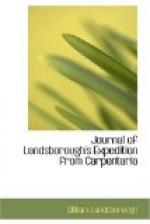In reply to questions:
Mr. Landsborough said he thought the Flinders River was about 500 miles long. The most elevated land on the Flinders appeared to be about 1000 to 1500 feet high. The climate of Carpentaria he believed to be very dry excepting in the months of January, February, March and April. The bed of the Flinders when he left it was 120 yards wide, with a shallow stream flowing along its surface. His party came through the country at a very favourable season of the year. Thunderstorms and rainy weather might be expected until the end of April, and sometimes as late as May. On the heads of the Gregory River the country was of a basaltic character; and on the Flinders there was abundance of quartz and ironbark country. He saw about 50 miles of the latter description of country and believed from his previous knowledge that it extended to the coast. The range dividing the Flinders from the Cooper River country he estimated to be from 1000 to 1500 feet high, while that which he crossed on his expedition to the south-west, though about the same height, was of quite a different character, being composed of a basalt different from any he had seen before. The slopes of the tableland were grassed with spinifex, which is almost worthless. All basaltic country he had seen previously in other parts of Australia was exceedingly well grassed.
He had no doubt that the rivers on the north side of Barkly’s Tableland were supplied by springs. Barkly’s Tableland divides the northern from the southern waters. He crossed it on his first expedition. He had never been to the west of the Thomson. Immediately after leaving the watershed of the Flinders he got onto that of the Thomson. On returning to the Albert from his expedition to




